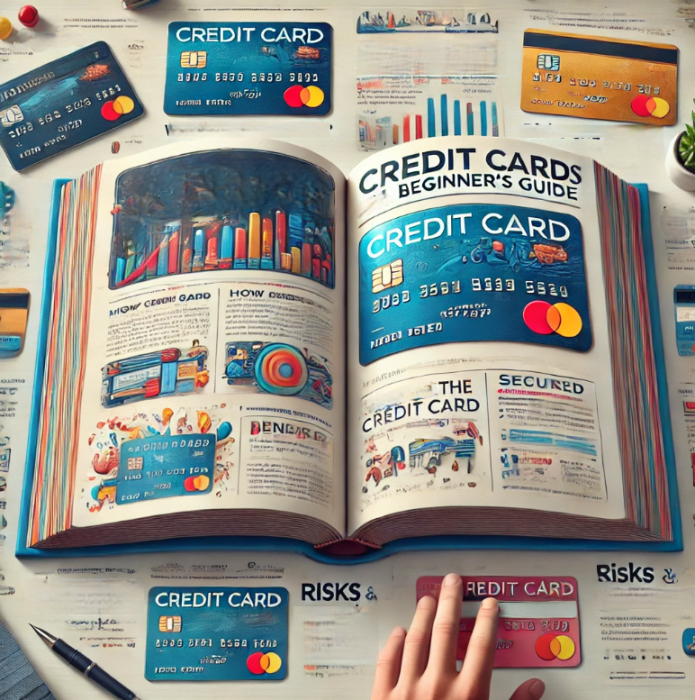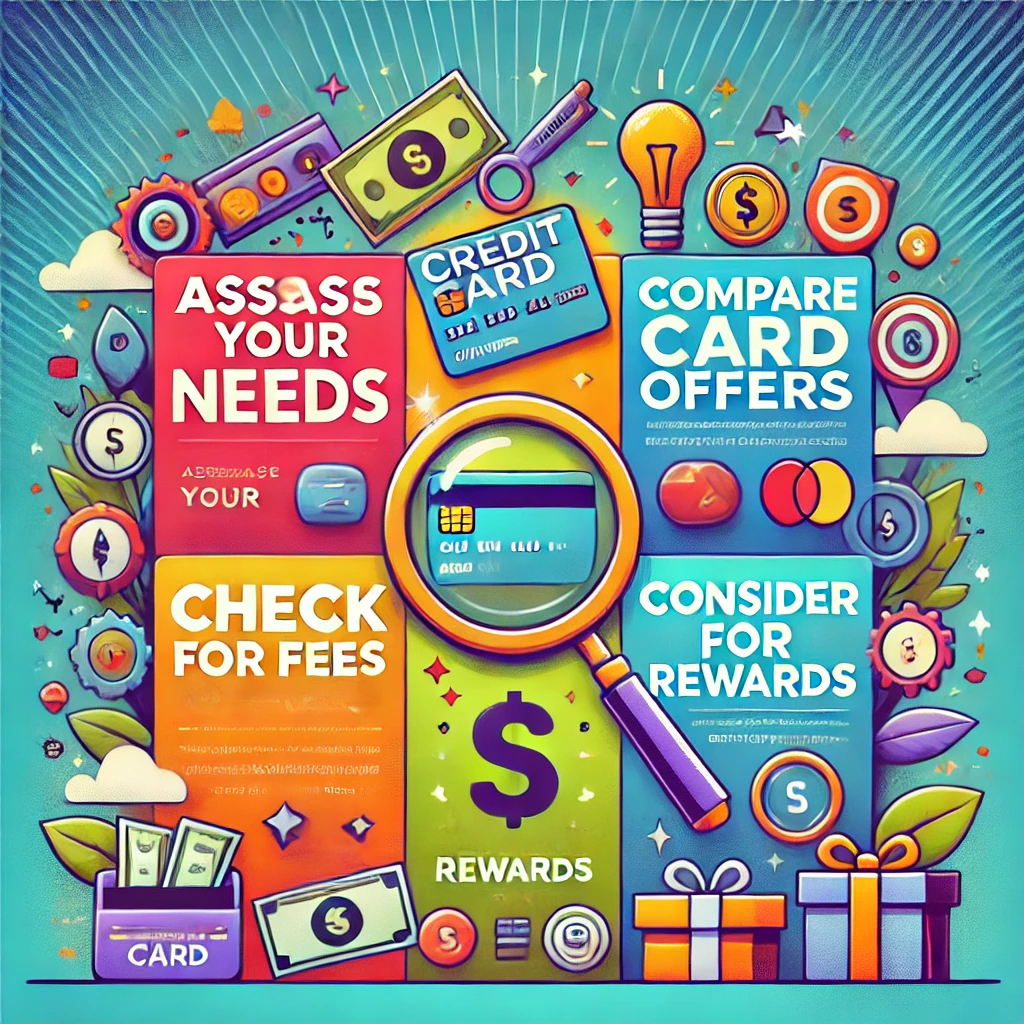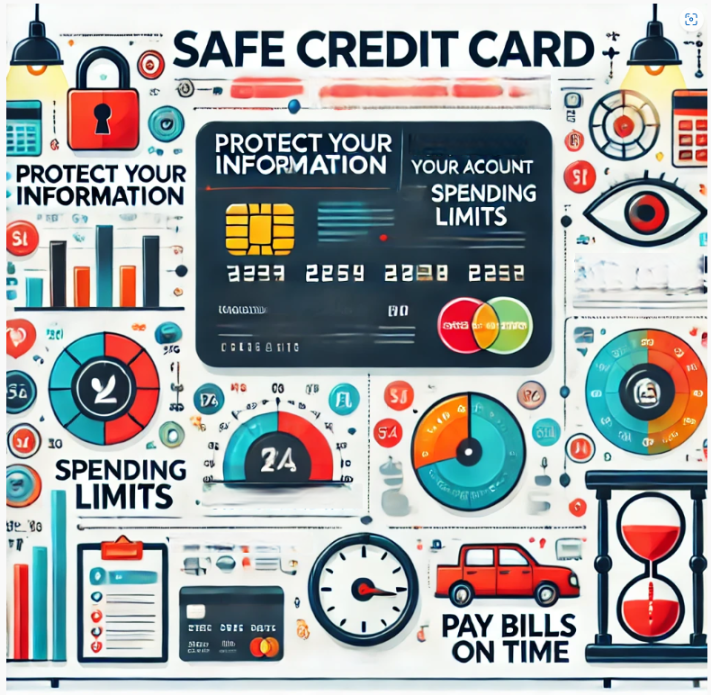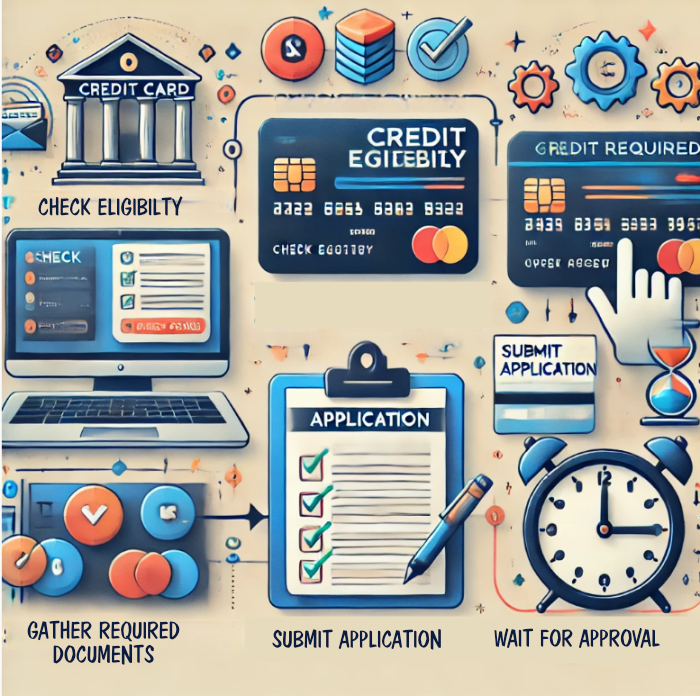Credit Cards for Beginners: A Beginner’s Guide
The majority of the links on our website are affiliate links. This means that if you click on the link and make a purchase, we earn a small commission at no additional cost to you.

Credit gives an individual the ability to borrow money with the promise to repay it in the future. Individuals can make purchases or investments without having immediate funds. Credit cards are a type of credit called revolving credit. Revolving credit does not have a fixed ending date like a loan does. You use the credit as desired, pay it off, and then use more credit. The credit account goes on and on until it is closed.
Definition and Basics
A credit card is a small plastic or metal card issued by a bank or financial institution. You are able to borrow money up to a certain limit to make purchases. When you use a credit card, the issuer is essentially giving you the money for the purchase. You’re expected to pay back the money you’ve borrowed by the due date each month. If you don’t pay it all back, you’ll be charged interest on the remaining amount.
Difference from Debit and Prepaid Cards:
- Debit Cards: When you use a debit card, the money comes directly from your checking account. You’re using your own money to make purchases, not borrowing from a financial institution.
- Prepaid Cards: Prepaid cards are loaded with money in advance. Once the card is loaded, you can use it like a debit card, but only up to the amount you pre-loaded. There’s no borrowing involved.
Types of Credit Cards
Credit cards come in various forms to suit different financial needs and goals:
- Standard Credit Cards: These are the most basic type of credit cards. They don’t have many extra features, if any at all.
- Rewards Credit Cards: These cards offer rewards on your spending. The rewards can come in the form of points, miles (for airline tickets), or cash back. Rewards cards are great for people who pay off their balance each month and want to earn something back for their spending.
- Secured Credit Cards: Secured cards require you to make a deposit as collateral before you can use the card. The credit limit usually matches the deposit amount. These cards are designed for people looking to build or rebuild their credit history because they generally have easier approval criteria than standard credit cards.
- Student Credit Cards: These are designed for college students who are new to credit. They usually have lower credit limits and may offer rewards suitable for younger people’s spending patterns, like rebates on groceries, dining, and entertainment.
How Credit Cards Work?

Understanding the following aspects of how credit cards work can help you use them more wisely, ensuring you manage your finances better and avoid costly interest payments.
Charges and Billing
When you use a credit card to buy something, you’re not immediately paying for the item with your own money. Instead, your credit card company pays the merchant, and you later repay the credit card company. This transaction shows up on your credit card statement, which is a detailed list of all the transactions made during a billing cycle (usually about 30 days).
At the end of each billing cycle, the credit card company sends you a statement with the total amount you owe, known as the balance. This statement will also tell you the minimum amount you need to pay by a certain due date and the total balance if you want to avoid paying interest.
Interest Rates (APR)
APR, or Annual Percentage Rate, is the yearly interest rate charged on outstanding balances. If you don’t pay your entire balance by the due date, the credit card company will charge interest on the remaining amount. For example, if your credit card has an APR of 20%, this rate is typically divided by 12 (months in the year) to find the monthly rate. So, if you carry over a balance of $100, you’ll incur about $1.67 in interest for that month on this balance.
Minimum Payments
The minimum payment is the smallest amount you must pay on your credit card bill to keep the account in good standing. This amount is usually a small percentage of your total outstanding balance, often around 2% to 3%, or a set dollar amount, typically $25 or $30, whichever is higher.
Implications of Making Only Minimum Payments: Making only the minimum payment means you’ll accumulate interest on the remaining balance, which can add up over time. This can make the total cost of the items you purchased much higher due to the added interest. Additionally, consistently making only minimum payments can extend the time it takes to pay off your balance significantly and may impact your credit score, as it may appear you’re struggling to manage your debt effectively.
Benefits of Using a Credit Card

Building Credit
Using a credit card responsibly is one of the most effective ways to build your credit history. Here’s how it works:
- On-time Payments: Each time you make a payment on time, your credit card issuer reports this to the credit bureaus. Consistent, on-time payments show that you are reliable and can manage debt responsibly, which helps build your credit score.
- Credit Utilization: This is the ratio of your credit card balance to your credit limit. Keeping this ratio low (generally recommended below 10%) shows that you are not overly reliant on credit, which positively impacts your credit score.
- Length of Credit History: The longer your accounts are open and in good standing, the better it is for your credit score. Using a credit card over a long period and keeping the account active and in good standing can help enhance your credit profile.
Rewards and Benefits
Credit cards often come packed with various rewards and perks that can make them financially rewarding, especially if you pay off your balance each month to avoid interest charges. Here are some of the rewards and benefits:
- Points: Many credit cards offer points for every dollar spent. These points can be redeemed for merchandise, gift cards, or even travel. But never use this as an excuse to make purchases. Carrying a balance every once in a while, happens, but if you are not able to pay off the entire balance every month, it’s a sign of living above your means and will be a journey to back on track.
- Cashback: Some cards offer cashback as a percentage of the amount you spend. This can be a great way to earn back a part of what you spend on your purchases.
- Travel Rewards: Travel credit cards specifically offer miles that can be redeemed for airline tickets, hotel stays, and other travel-related expenses. They may also offer additional travel benefits like airport lounge access, priority boarding, and baggage fee waivers.
- Insurance and Extended Warranties: Credit cards often come with a variety of insurance options, such as travel insurance, rental car insurance, and even product purchase protection. They can also extend the manufacturer’s warranty on products you buy, giving you extra peace of mind and potentially saving you money in the long run.
- Exclusive Discounts and Offers: Cardholders often get access to exclusive discounts and promotional offers, including special events, sales, and promotions not available to the general public.
Risks and Pitfalls

While credit cards offer numerous benefits, they also come with potential downsides if not managed carefully. Understanding these risks can help you use credit cards wisely and avoid the pitfalls that lead to financial strain. It’s important to use credit cards responsibly by budgeting properly, keeping track of your expenses, and understanding all the terms and fees associated with your card.
Debt Accumulation
One of the primary risks of using credit cards is the temptation to spend more than you can afford. Here’s how this can become problematic:
- High-Interest Debt: Credit cards typically have high interest rates, especially if you only make the minimum payment. This can lead to a cycle of debt that grows over time, making it difficult to pay off.
- Overspending: With easy access to credit, it might feel like you can buy anything at any time. This can lead to spending beyond your means, which can quickly add up to unmanageable debt levels.
Fees
Credit cards can come with various fees that can increase the cost of having a card:
- Annual Fees: Some credit cards charge a yearly fee for usage, especially cards that offer significant rewards or benefits. While sometimes these fees are justified by the benefits provided, they can be burdensome if you don’t make full use of the card’s offerings.
- Late Payment Fees: Failing to make payments on time can lead to hefty fees. Consistent late payments can also result in increased interest rates.
- Foreign Transaction Fees: Some cards charge extra fees for transactions made in a foreign currency or on purchases made from foreign merchants. These fees can add up if you travel often or purchase goods from international sellers online.
Credit Score Impact
Misusing a credit card can have a significant negative impact on your credit score:
- High Credit Utilization: Using a large portion of your available credit limit can signal to creditors that you are over-reliant on credit, which can lower your credit score.
- Late or Missed Payments: Your payment history is a significant factor in your credit score. Late or missed payments can severely damage your score.
- Applying for Multiple Cards: Each time you apply for a credit card, a hard inquiry is made on your credit report, which can temporarily lower your score. Applying for many cards in a short period can compound this effect.
Choosing the Right Credit Card

Choosing the right credit card is crucial to maximizing its benefits while minimizing costs and potential financial risks. Here’s a simple guide to help you select a credit card that best fits your needs and spending habits. Credit cards in general have high interest rates because for the creditor, this type of credit is riskier than the other types.
Assessing Needs and Habits
Before you start looking for a credit card, take a moment to assess your financial situation and spending habits:
- Spending Patterns: Consider what you spend the most money on each month. If you spend a lot on groceries and gas, look for a card that offers rewards in those categories. If you travel frequently, a travel rewards card might be more beneficial.
- Financial Goals: Think about what you want from a credit card. Are you looking to build or improve your credit score? Are you interested in earning rewards or cash back? Your goals will guide your choice.
- Payment Habits: Are you likely to pay off your balance in full each month, or do you anticipate carrying a balance? If you plan to pay in full, a card with rewards and perhaps a higher APR might be fine. If you’ll carry a balance, look for a card with a low interest rate.
Comparison Shopping
Once you have a clear understanding of your needs, start comparing different credit card offers. Here’s what to look for:
- Annual Percentage Rate (APR): The APR is critical if you plan to carry a balance. A lower APR will save you money on interest charges. Compare the APRs for purchases.
- Fees: Look for a card with no annual fees or monthly fees. Also, check for other fees like late payment fees, balance transfer fees, and foreign transaction fees.
- Rewards and Benefits: Evaluate the rewards program. If a card offers points or cash back, check how and where you need to spend to earn these rewards. Also, consider how easy it is to redeem the rewards. For travel cards, look at the types of travel benefits offered, such as airport lounge access or travel insurance.
- Introductory Offers: Many cards offer introductory rates and bonuses, such as 0% APR for the first 12-18 months or a bonus if you spend a certain amount within the first few months. These offers can be very beneficial if used wisely.
- Credit Requirements: Ensure you meet the credit requirements for the card. Some cards require excellent credit, while others are more forgiving and aimed at building or repairing credit.
Safe Credit Card Practices

It’s important to use credit cards not only wisely but also safely. Here’s how you can protect yourself from fraud and manage your finances effectively when using a credit card.
Security Measures
Credit cards are convenient, but they can also be targets for fraud and theft. Here are some simple steps you can take to protect yourself:
- Keep Your Card Information Safe: Never share your credit card number, expiration date, or CVV (the three-digit number on the back) with anyone you don’t trust. Be cautious when entering your card details online; make sure the website is secure (look for “https://” in the URL).
- Use Strong Passwords: When managing your credit card account online, use strong, unique passwords. Avoid using easily guessed passwords like “123456” or “password.” Consider enabling two-factor authentication (2FA) for an extra layer of security.
- Monitor Your Accounts Regularly: Check your credit card statements and online account frequently to ensure all transactions are accurate. If you notice any unfamiliar charges, report them to your credit card issuer immediately.
- Report Lost or Stolen Cards Immediately: If your card is lost or stolen, report it to your credit card company right away. They can freeze the account to prevent unauthorized charges and issue you a new card.
- Be Cautious with Public Wi-Fi: Avoid accessing your credit card account or making purchases over public Wi-Fi networks, as they can be less secure. If you need to use public Wi-Fi, consider using a Virtual Private Network (VPN) to protect your data.
- Sign Up for Alerts: Many credit card companies offer free alerts that notify you of suspicious activity, large purchases, or when your balance reaches a certain level. These alerts can help you detect and respond to fraud quickly.
Financial Management
In addition to keeping your credit card secure, managing it responsibly is crucial for maintaining good financial health. Here’s how:
- Set a Budget: Just because you have a credit limit doesn’t mean you should spend up to that limit. Set a budget based on what you can afford to pay off each month. This will help you avoid overspending and accumulating debt.
- Pay Off Your Balance in Full: Whenever possible, pay off your credit card balance in full each month. This will help you avoid interest charges and keep your debt under control. If you can’t pay the full balance, try to pay more than the minimum payment to reduce your interest costs.
- Track Your Spending: Keep an eye on your spending throughout the month. Many credit card issuers offer tools that categorize your spending, so you can see where your money is going. This can help you stick to your budget and identify areas where you might cut back.
- Review Your Statements: Carefully review your credit card statement every month to ensure all the charges are correct. This is also a good time to check for any fees or interest charges you may not have been aware of.
- Avoid Impulse Purchases: Credit cards make it easy to buy things on a whim, but those impulse purchases can add up quickly. Take a moment to ask yourself if you really need an item before buying it.
- Plan for Large Purchases: If you plan to make a large purchase, consider how it fits into your budget and how long it will take to pay off. If you’ll need to carry a balance, calculate how much interest it will cost you.
How to Apply for a Credit Card

Applying for a credit card is a straightforward process, but it’s important to understand the eligibility requirements and what to expect during the application process. Here’s a simple guide to help you through it.
Eligibility and Application Process
1. Eligibility Requirements:
- Age: You must be at least 18 years old to apply for a credit card on your own.
- Income: You need to have a source of income to show that you can repay any money you borrow. The requirements can vary, but issuers will often ask for details about your employment and income.
- Credit History: Credit card issuers will look at your credit history to determine your creditworthiness. If you have no credit history, you might need to start with a secured credit card or a student credit card.
- Residency Status: Most issuers require you to be a resident of the country where you are applying for the credit card.
2. Application Process:
- Research: Start by researching different credit cards to find one that matches your needs in terms of rewards, interest rates, and other benefits.
- Pre-qualification: Some issuers offer a pre-qualification process, which allows you to see if you might be approved without affecting your credit score.
- Apply: Once you choose a card, you can apply online, by phone, or in person at a bank or credit union. You’ll need to provide personal information such as your name, address, Social Security Number (SSN), income, and employment details.
- Verification: The issuer might ask for additional documentation to verify your income or identity, such as a copy of your driver’s license or a recent payslip.
What to Expect
Credit Checks:
- Hard Inquiry: When you formally apply for a credit card, the issuer will perform a hard inquiry (or hard pull) on your credit report to review your creditworthiness. This typically causes a temporary dip in your credit score by a few points.
- Impact on Credit Score: The impact of a hard inquiry usually lasts for a few months, but the inquiry itself can remain on your credit report for up to two years. Applying for several credit cards in a short period can compound this effect, causing a more significant drop in your score.
Approval or Rejection:
- After the credit check and review of your application, the issuer will either approve or deny your application. If approved, you’ll be informed of your credit limit and other card details.
- If rejected, you are entitled to know why. Common reasons include low income, high debt-to-income ratio, or a poor credit history. You can use this information to address any issues before applying again.
Receiving Your Card:
- If approved, your credit card will be mailed to you. You’ll need to activate it following the instructions provided, usually either online or by phone.
Understanding these steps and what to expect can help you approach the credit card application process more confidently and increase your chances of approval.
Glossary of Key Credit Card Terms

This glossary should help beginners understand the most common terms found in credit card statements and contracts, making it easier for them to manage their accounts effectively.
- Annual Fee: A yearly charge some credit cards have just for using the card. Not all cards have an annual fee.
- Annual Percentage Rate (APR): The yearly interest rate charged on outstanding balances. This rate is applied if you don’t pay your full balance by the due date.
- Balance: The amount of money you currently owe on your credit card.
- Balance Transfer: Moving the balance (debt) from one credit card to another. This is often done to take advantage of a lower interest rate on the new card.
- Billing Cycle: The period for which your credit card statement is generated. It’s usually about one month but can vary slightly by issuer.
- Cash Advance: Using your credit card to withdraw cash. This typically has a higher interest rate than regular purchases and may include additional fees.
- Credit Limit: The maximum amount of credit a credit card issuer will allow you to borrow at any one time.
- Credit Utilization Ratio: The percentage of your credit limit that you’re currently using. It is calculated by dividing your total credit card balances by your total credit limits.
- Due Date: The date by which the minimum payment must be made on your credit card. Failure to meet this deadline can result in late fees and interest charges.
- Interest: The cost of borrowing money on your credit card. It’s charged when you carry a balance beyond the grace period.
- Minimum Payment: The smallest amount you must pay on your credit card bill to avoid late fees and keep the account in good standing.
- Overlimit Fee: A fee charged when your spending exceeds your credit limit.
- Statement: A monthly document that details all transactions, fees, payments, and outstanding balances. It’s important to review this document to ensure all information is accurate.
- Variable Rate: An interest rate that can change based on an index such as the prime rate. This means your APR could increase or decrease.
- Grace Period: The time between the end of your billing cycle and the date your payment is due. During this period, you may not be charged interest on new purchases if you paid your previous balance in full.
Comparing Credit Card Offers

Review multiple offers to find the best fit. Look at several cards side by side, comparing annual fees, APRs, credit limits, and rewards.
Secured vs. unsecured cards: Secured cards require a deposit that serves as your credit limit. They are easier to get but may have fewer perks. Unsecured cards don’t require a deposit but might be harder to qualify for.
Introductory offers can provide benefits like 0% APR for an initial period or a signup bonus. These can be great for getting started, but make sure to read the fine print on when these offers end.
Customer service and support: Look into how easy it is to reach customer support and what other users say about their experiences. Good customer service can be invaluable, especially for a first-time cardholder.
The following are affiliate links, I will be compensated if you apply and are approved for the credit card
Capital One Platinum Secured Credit Card // No Annual Fee// 29.99% APR (variable)
Discover it Secured Credit Card//No Annual Fee//28.24% APR (variable)
Capitol One Platinum Mastercard// No Annual Fee//29.99% APR (variable)
Capitol One Quicksilver Secured Rewards// No Annual Fee//29.99% APR (variable)
Discover it Cash Back//No Annual Fee// 18.24%- 28.24% APR (variable)